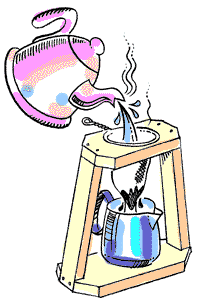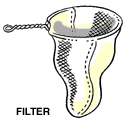
A secret recipe for preparing a superb cup of Costa Rican coffee using the traditional, Chorreador de cafe. Complete step-by-step illustrated instructions.

A secret recipe for preparing a superb cup of Costa Rican
coffee using the traditional, Chorreador de cafe.
Complete step-by-step illustrated instructions.
by Ana Isabel Herrera Sotillo
 About twenty years ago almost every home, restaurant and office
kitchen in Costa Rica was equipped with a coffee making device called Chorreador
de café. It consisted of an unvarnished
wooden frame about 33 cms. tall, with a round hole at the top where a wire
rimmed cloth filter or strainer was placed. Fine ground coffee was placed
in the filter and boiling water was poured in filtering down to the coffeepot
below. This humble device is losing ground fast to modern percolators, coffee
makers and Mr. Coffee machines. The reason usually given is that the new
devices are said to be faster and more convenient. In our home the Chorreador
de café lives on. Why? The coffee simply tastes better.
About twenty years ago almost every home, restaurant and office
kitchen in Costa Rica was equipped with a coffee making device called Chorreador
de café. It consisted of an unvarnished
wooden frame about 33 cms. tall, with a round hole at the top where a wire
rimmed cloth filter or strainer was placed. Fine ground coffee was placed
in the filter and boiling water was poured in filtering down to the coffeepot
below. This humble device is losing ground fast to modern percolators, coffee
makers and Mr. Coffee machines. The reason usually given is that the new
devices are said to be faster and more convenient. In our home the Chorreador
de café lives on. Why? The coffee simply tastes better.


Coffee making is an art where every step should be followed closely. Some advice given below may seem superfluous but should be rigorously adhered to.
Bring the water to a boil. The water should be fresh tap water and not
reheated from water left in the coffeepot.
Place two tablespoons of fine ground coffee into the filter, then mount
the filter on the wooden stand. Two tablespoons of coffee produce four cups
of coffee.
Place a glass or stainless steel receptor under the filter and begin to
slowly pour the boiling water into the filter. You may have to stop occasionally
so that the level of water drops. Continue pouring as needed until you have
the four cups. Do not introduce metal spoons into the filter to agitate
the mixture.
In the future you can experiment by adding a touch of cinnamon or vanilla
or chocolate or cloves to the mixture.
Top the coffeepot and serve.
If you prepare coffee two or more times a day, you will probably need two filters. The reason for this is that if you use only one, it is likely that it will not be totally dry the next time you brew coffee. By using alternating filters you will always have a dry one on hand. Filters are best dried in the sunlight.
For daily use you should carefully rinse the filters in running tap water
to remove all residue. It is natural that it will stain. You should now
worry about this as it is normal.You should wash the filter weekly. Never
wash the filter in soap or detergent, wash it only with salt
to remove the accumulated grease. This can be done by generously salting
the damp bag and virgorously rubbing it. Afterwords you should thoroughly
rinse the filter to remove all traces of salt.
If you are in a hurry, go ahead use instant coffee or your Mr. Coffee maker,
but if you want a REAL cup of coffee, you are going to
have to put some effort into preparation. I hope that this article inspires
those Costa Ricans who have forgotten this charming way of brewing coffee.
For those who would like to build the coffee stand I recommend that you
visit the RunnerDuck
Resources page where you will find detailed instructions for building
the stand and a pattering for sewing the filter.
Comments or suggestions to Ana Isabel Herrera Sotillo.